
‘Afraid of the water’? Life in a city that dumps billions of litres of raw sewage into lakes and rivers
10 billion litres of sewage are dumped into Winnipeg’s lakes and rivers each year. Some...
Four years ago, on a morning hike with her husband, Heather McIntyre spotted red and white flagging tape near a creek that supplies much of the drinking and irrigation water for her village of Glade in a pastoral Kootenay valley.
The tape marked logging boundaries and roads and was stamped with “KLC,” the initials of a local timber company, Kalesnikoff Lumber Co., which planned to log in the community’s watershed on the slopes of a low-lying Selkirk Mountain in the interior rainforest.
“We kind of panicked,” said McIntyre, who lives in a yellow strawbale house amidst a patchwork of fruit and vegetable gardens, in a community named Dolina Plodorodnaya by its Doukhobor founders, meaning “fertile valley.”
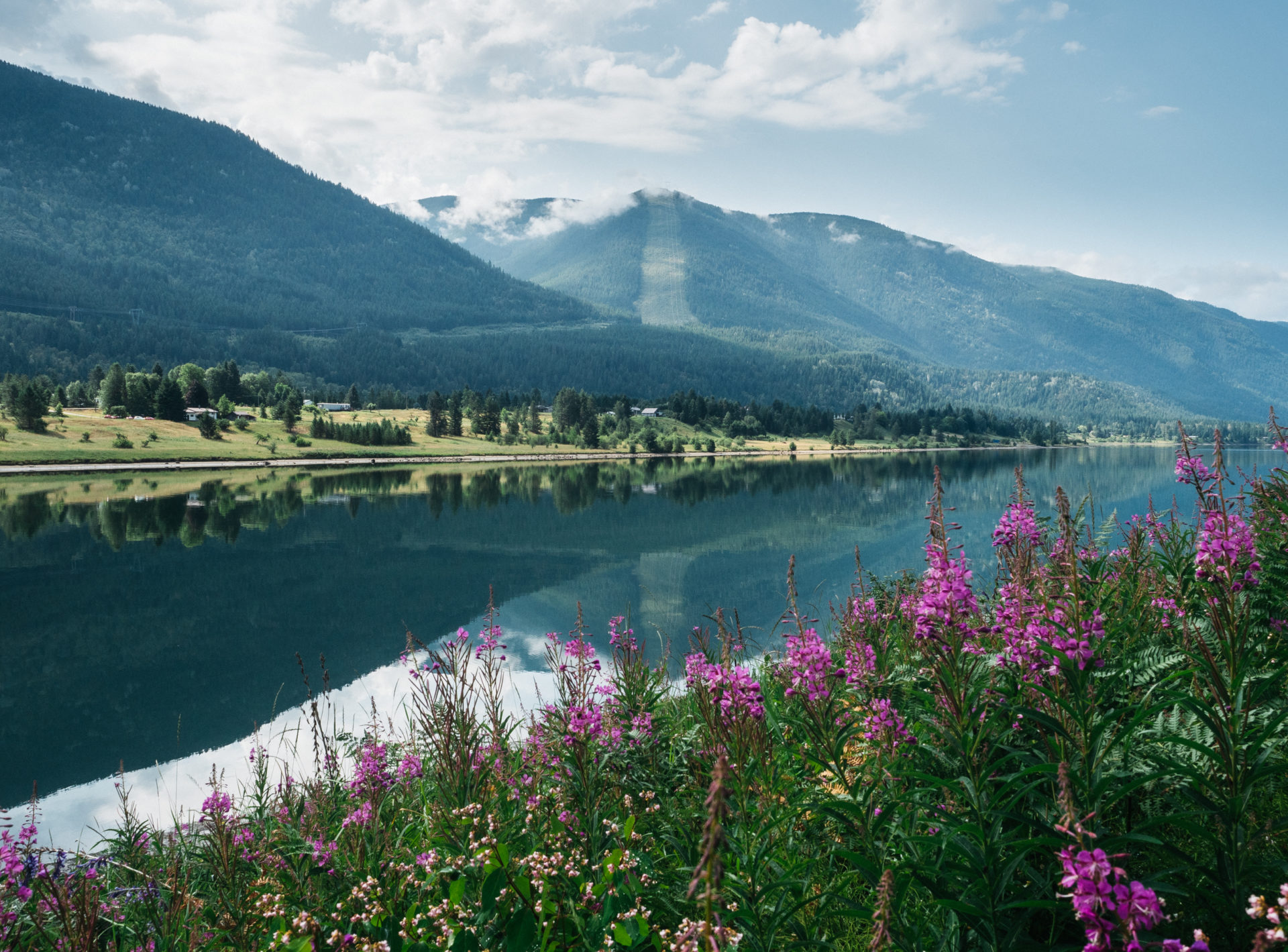
The community of Glade sits on the banks of the Kootenay River near Nelson, B.C. The Glade Creek watershed has been at the centre of an ongoing dispute between community members and two logging companies — ATCO and Kalesnikoff Lumber Co — who have been given cut permits in the drainage. Photo: Louis Bockner / The Narwhal
“Everybody in the lower part of Glade gets their
water from the creek and the logging flagging was right above the creek,” McIntyre told The Narwhal. “We’re using a lot of water in summer for irrigating and then there’s our drinking water.”
Since then, McIntyre and other Glade residents have been using their green thumbs to tap on the space bar of computer keyboards, writing long letters to politicians and organizing petitions and legal actions.
They have sought every possible recourse to stop logging by Kalesnikoff and a second local company, Atco Wood Products, on the grounds that Glade’s drinking water quality and flow could be affected by conventional logging, primarily clear-cutting, that is slated to begin as early as this summer.
In April, after Glade residents sought a temporary injunction against the two companies, B.C. Supreme Court Justice Michael Tammen stated that any potential change to water quality caused by logging would not be “irreparable” because it could be remedied by additional water treatment.
If the injunction were granted, on the other hand, Tammen said the two timber companies would suffer “irreparable” injury due to “obvious economic harm.”
“Do you have a right to clean water?” B.C. Supreme Court Justice Mark McEwan said in court. “I’d suggest you don’t … there just is nowhere in the law where you can look and say, ‘there it is — there’s my right. I have a right to clean water.’ ”
McIntyre said the ruling was “a kick in the gut,” hurting all the more because costs were awarded to the logging companies, compelling Glade residents to raise more than $10,000.
“You can’t drink money,” said Heather McSwan, a weaver and spinner who owns the Bee Glade nursery in the village of 300, reachable only by a 10-car cable ferry across the Kootenay River.
“This is our water that we’re talking about … We don’t get a second chance at this. When the timber’s gone the environment is impacted in a way that will result, somewhere down the road, in the degradation of the water, especially with climate change coming.”
“That’s the wild card.”
Across B.C., communities like Glade are grappling with imminent plans for clear-cut logging in watersheds that supply their drinking, irrigation and, in some cases, fire-fighting water.
B.C. has more than 460 designated community watersheds, but only the water catchment basins supplying the Vancouver and Victoria areas are protected from logging and other industrial development.
“Glade is a microcosm, one example of a huge problem throughout the province of B.C.,” said registered professional forester Herb Hammond, who lives in the Slocan Valley and mentors the Glade Watershed Protection Society.
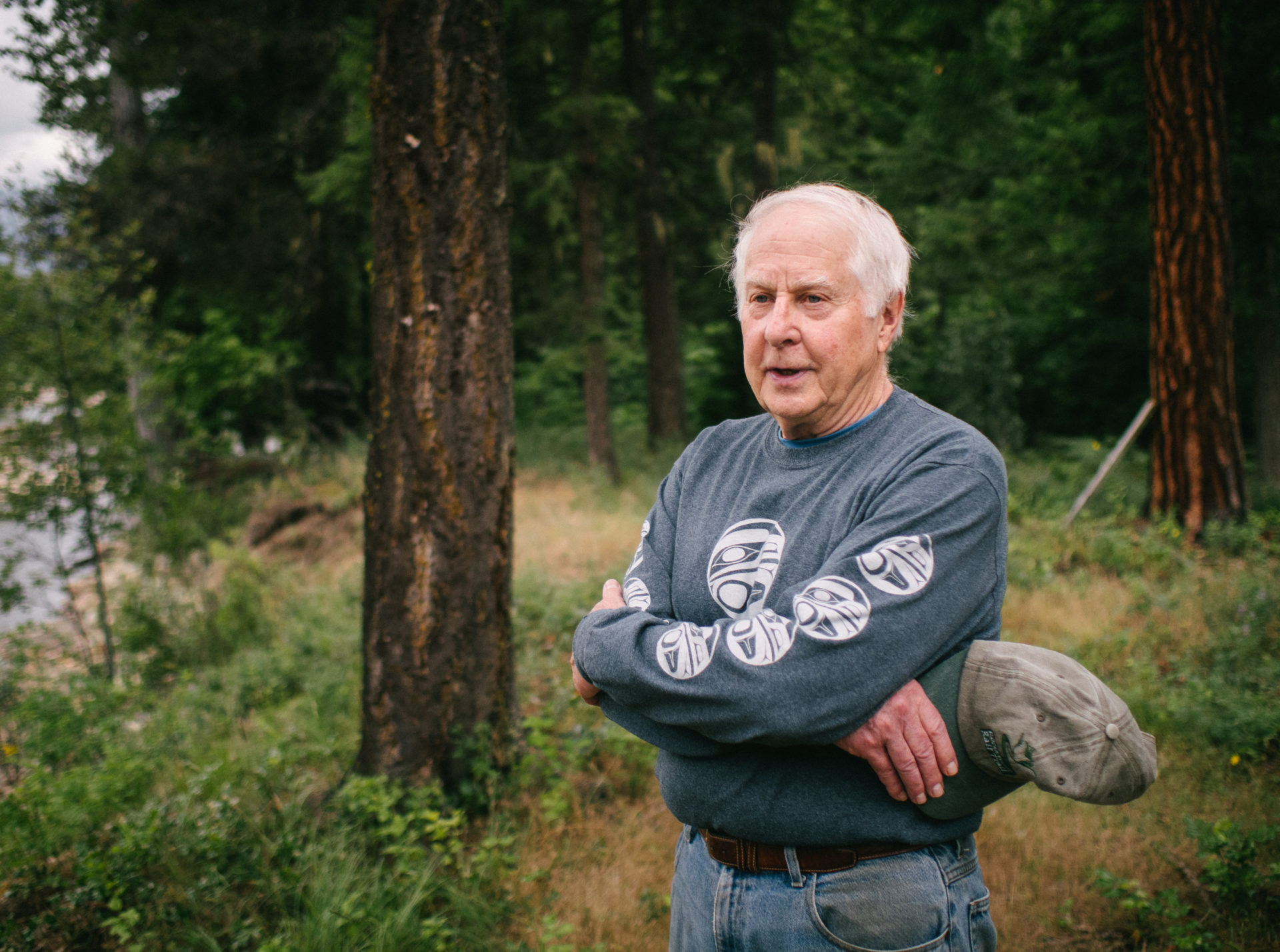
Forester and ecologist Herb Hammond, seen here at his home in Vallican, B.C., has worked as an independant consultant for the Glade Watershed Protection Society. Photo: Louis Bockner / The Narwhal
“Canadian provinces are amongst the few, or maybe the only, jurisdictions left that have given — and given is the right word because the amount they received for it was a pittance — the rights to public forests to private timber companies,” Hammond said in an interview.
“Once that’s done it becomes difficult to get back.”
Forestry companies are moving into B.C.’s community watersheds with increasing speed as they run out of logging options elsewhere. That’s left communities like Glade, along with the regional districts that represent them, in a bind because they don’t have control over their watershed lands yet face the potential costs of cleaning up the water.
In Peachland in the Okanagan, where extensive logging has taken place nearby, a landslide downslope of a logging road contributed to boil-water advisories and the need for a new $24 million water treatment plant funded by the community. In Grand Forks, sprawling clearcuts are believed to have played a major role in a monster flood in 2018 that inundated houses and led to the closure of 28 downtown businesses.
In the Regional District of Central Kootenay — which stretches from the U.S. border to north of Nakusp and includes Glade and the cities of Nelson and Castlegar — at least seven communities face clear-cut logging on slopes that are home to the creeks that supply their drinking water.
Regional district chair Aimee Watson called it a “major” issue for the district, which has sought answers from the provincial government about issues such as community safety in the event of landslides or flooding, finding little solace in replies.
“We know that the annual allowable cut, as it runs out, was going to hit watersheds. And we’ve hit that point,” Watson told The Narwhal.
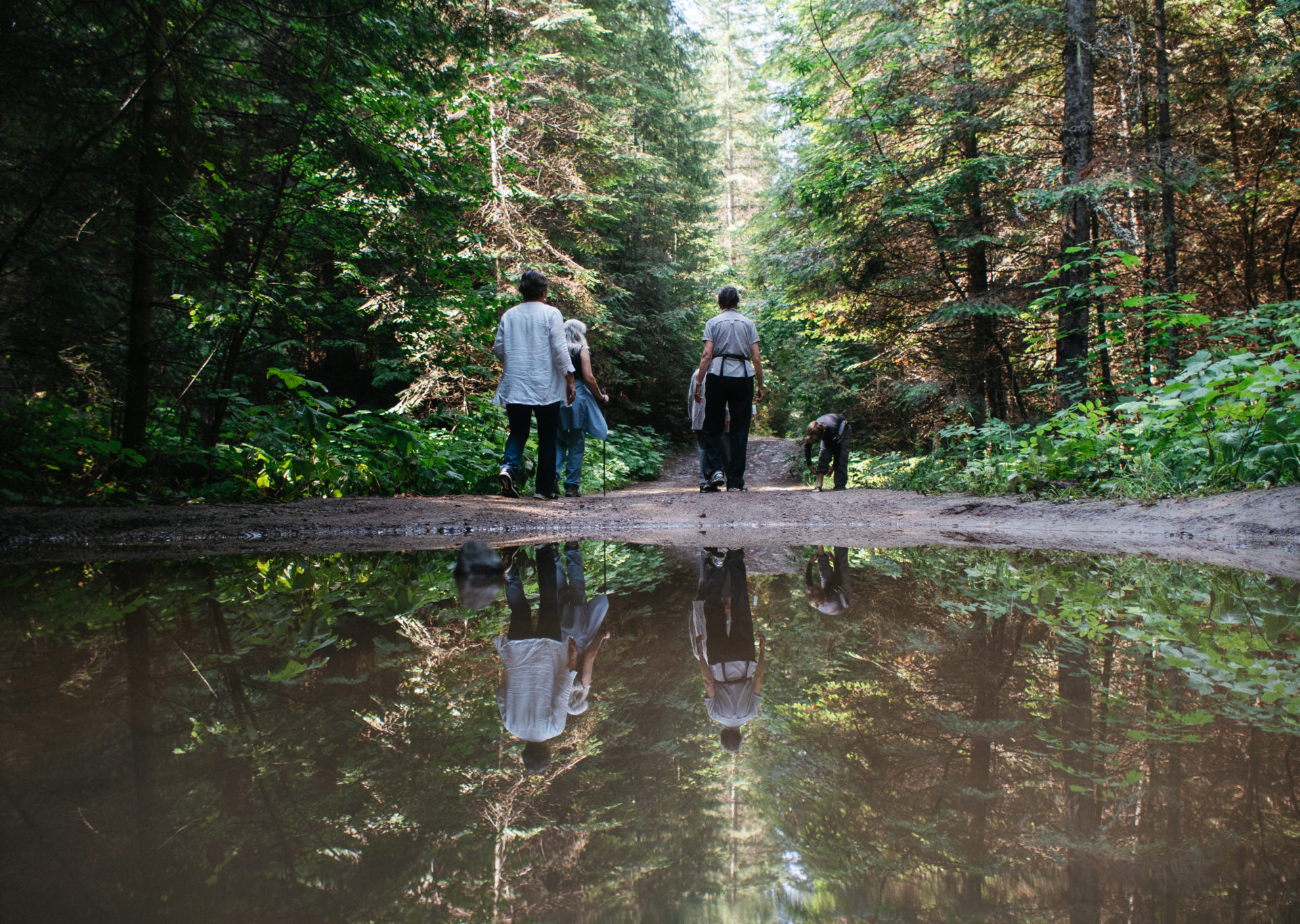
Members of the Glade Community walk through the lower portion of the watershed. Should the proposed logging go ahead this road would be widened to accomodate logging truck traffic. Photo: Louis Bockner / The Narwhal
Watson said she has repeatedly asked the B.C. government who will pay for new water sources or water treatment if there is a problem after logging.
Her understanding from the B.C. forests ministry is that fault will be determined by the courts, if a community sues a logging company once a problem arises.
“You have to prove it,” Watson says. “I don’t want to rely on having to sue a logging company to prove fault after a devastating issue has occurred, whether that’s loss of water or a landslide.”
Local governments are in a conundrum, Watson pointed out. They are responsible for the safety of residents in communities like Glade — and for emergency responses in the event of flooding or landslides — yet they have no decision-making authority when it comes to how watersheds are managed.
Climate change is only heightening concerns, with scientists predicting changes to snow packs and increased spring precipitation in the Kootenays will lead to larger and earlier spring freshets, increasing flood and landslide risks.
“I have a very big interest and responsibility for ensuring that whatever land activity occurs, even when I don’t have jurisdiction, is not going to cause a risk to the communities I represent,” Watson said.
According to Hammond, clear-cutting is often overlooked as a contributing factor to landslides and flooding.
“Clear-cutting is indefensible ecologically,” said Hammond, who is also an ecologist, ecosystem planner and author. “It’s a blot on the forest industry, particularly in the middle of a climate emergency, that we don’t own up to that.”
“If you think about maintaining the biological diversity of forests to withstand climate change then it doesn’t make any sense to log in watersheds.”
Older forests produce the highest quality water supplies and are best at moderating climate through carbon storage, Hammond pointed out.
“If you think about maintaining the biological diversity of forests to withstand climate change then it doesn’t make any sense to log in watersheds,” said Hammond, who has also worked on contract for the Glade Watershed Protection Society.
Glade’s watershed was logged about 120 years ago, leaving some remnant old-growth in its upper reaches, and Hammond said it’s especially important to leave the forest — with western red cedar, hemlock, white pine, larch and Douglas fir — undisturbed because the watershed is still in recovery mode.
“They [the B.C. government] are erring on the side of protecting corporate interests, not erring on the side of protecting ecosystems and communities.”
Seeking a solution, the Glade Watershed Protection Society, a volunteer-based public interest group, applied to the B.C. government to have Glade’s watershed designated a community forest, allowing local residents to make decisions about logging and other uses.
The society wrote four letters to Doug Donaldson, B.C.’s minister of forests, lands and natural resource operations, asking for a meeting. Their request was turned down in April 2018.
Donaldson’s assistant deputy minister, Gerry MacDougall, informed the Glade society in a letter that the request for a community forest agreement would be “difficult to meet” because the annual allowable cut allocated to community forests in the Selkirk forest district had already been used up.
“In order to further expand the program, a new government mandate would be required … ,” MacDougall wrote.
A community forest agreement “would provide employment, address wildfire issues, strengthen our quality and quantity of water, protect wildlife habitat and … protect the public interest,” the society subsequently wrote in a plea to Donaldson, Premier John Horgan and other politicians, asking the government to reconsider Glade’s application for a community forest.
McSwan pointed out that logging companies are not going to build Glade a new water treatment plant if water quality suffers after clear-cutting.
“The most ironic thing is that the logging companies … bear almost no responsibility … whereas the people who use the water and organizations that oversee the water, like the Glade Irrigation District, are solely responsible for the potability of the water,” McSwan said.
Kootenay Central Regional District director Andy Davidoff, who is responsible for the area that includes Glade, said more than 80 per cent of the timber tenures for local mills are in watersheds, including in “consumptive watersheds” supplying drinking water to Glade and other communities.
“We’re trying to figure out a more holistic approach,” Davidoff said in an interview. “We have a real problem here in the Interior.”
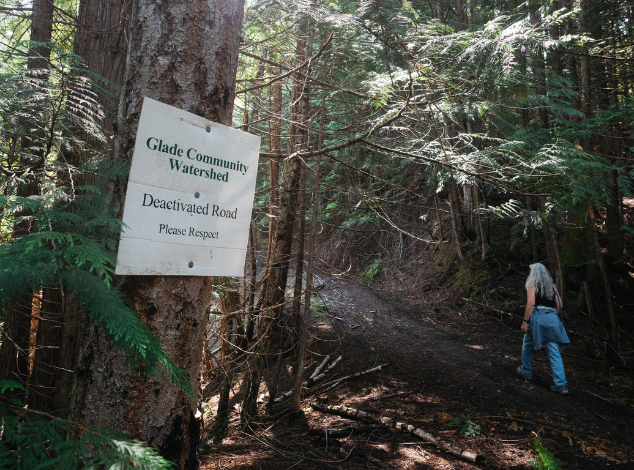
Heather McSwan walks through the Glade Community Watershed to the site of a 2017 slide that took out part of an old service road. Photo: Louis Bockner / The Narwhal
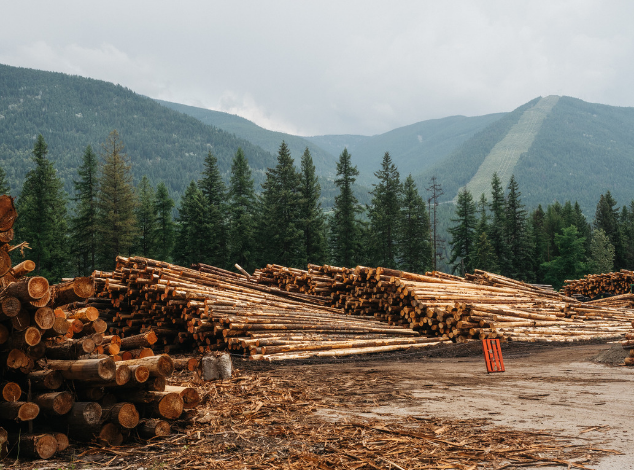
The Kalesnikoff Lumber Co’s lumber yard sits directly across the Kootenay River from Glade with the community’s watershed clearly visible across the valley. Photo: Louis Bockner / The Narwhal
Ideally, the B.C. government would swap logging tenures in community watersheds for tenures elsewhere, Davidoff said. “But the problem is that apparently there’s none to be had.”
Near Balfour, on the north shore of the west arm of Kootenay Lake, residents set up a protest camp in June at the base of a forest service road leading to planned logging around Laird Creek, and three people were arrested.
Residents of Argenta and Johnson’s Landing — where a 2012 landslide killed four people and buried and damaged homes following a deluge of rain — are asking the provincial government to protect local watersheds from planned logging on a mountain face along the east shore of Kootenay Lake between the two communities.
And in Ymir, a community of 230 between Nelson and Salmo, residents are deeply concerned about planned logging in the Quartz Creek watershed, which supplies all of the village’s potable and fire hydrant water.
Timber in the Quartz Creek watershed has been auctioned off by the Crown corporation BC Timber Sales, which has drawn ire for selling allotments of publicly owned old-growth forests in places like Schmidt Creek on Vancouver Island.
“It’s a very, very difficult situation and very sensitive situation for all of us,” Davidoff says, “when a Crown corporation like BC Timber Sales digs its heels in and says we’re not bending on our harvesting plan in a really sensitive watershed like Quartz Creek.”
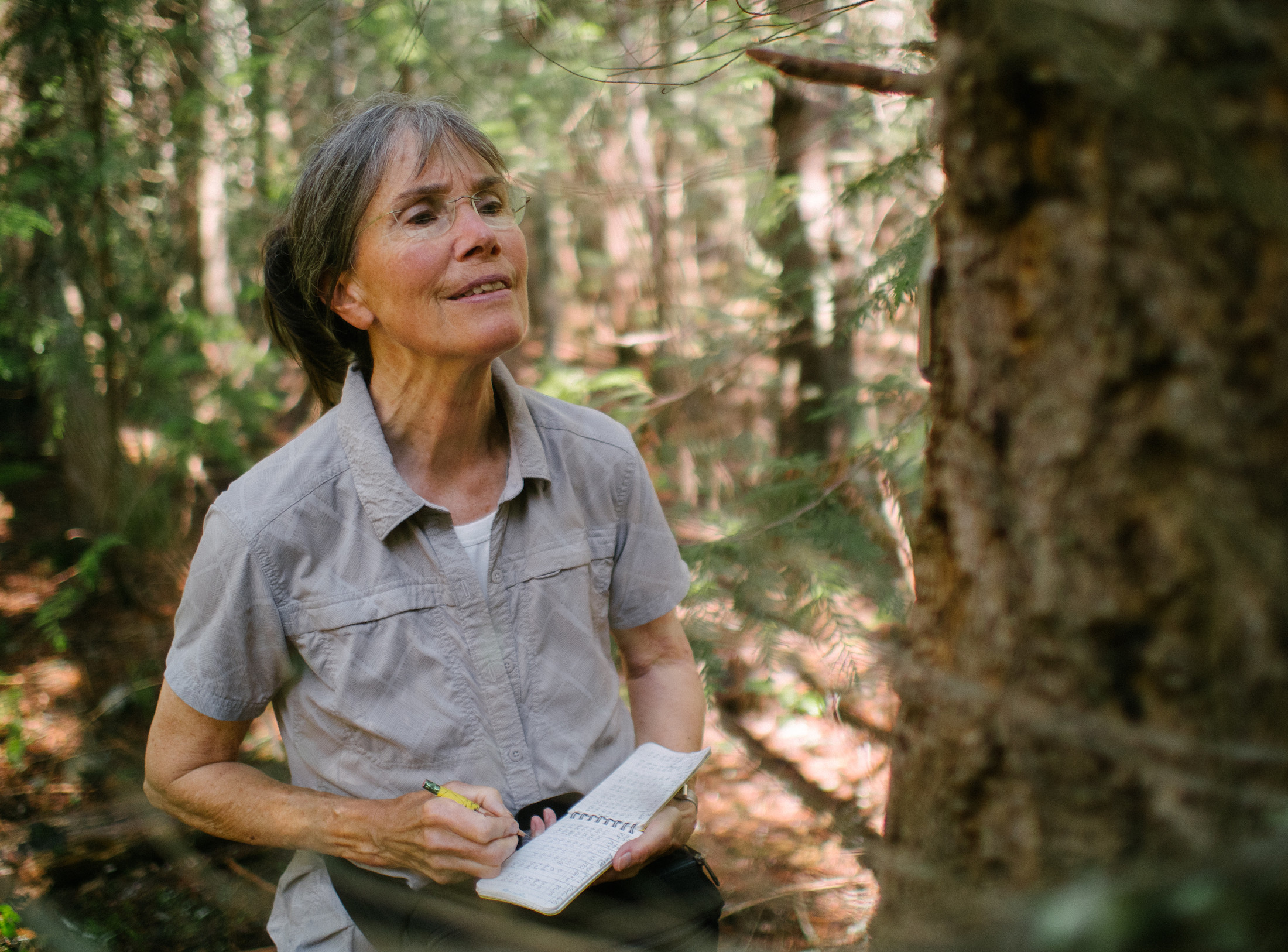
Heather McIntyre, member of the Glade Watershed Protection Society, notes ambient temperature readings in the Glade Creek watershed as part of the community’s ongoing monitoring program. They hope this data can provide a baseline should any changes occur when the watershed is logged. Photo: Louis Bockner / The Narwhal
Unusually, the regional district owns Ymir’s water system, which Watson said gives it more leverage than community-owned water systems like the Glade Irrigation District because it can negotiate directly with the B.C. government.
“We’ve got them to agree to ongoing water monitoring, which sounds like it should be pretty basic and done all along. But it wasn’t, and we really, really had to lobby for them to monitor the water.”
McIntyre said the B.C. forests ministry district office told Glade residents that watershed logging will not create new sediment sources.
But a hydrology report commissioned by the watershed protection society found the planned logging could threaten drinking water from Glade Creek — possibly rendering it non-potable due to elevated turbidity and contamination.
In addition to water data collected by the Glade Irrigation District, McIntyre said Glade residents have been collecting additional baseline water, temperature and discharge data each day and sending samples to a lab.
The issue of logging in community watersheds is cloaked in a jurisdictional tangle that creates the impression of provincial government indifference to the quandary facing Glade and other communities.
When the Glade Watershed Protection Society wrote to Environment Minister George Heyman to request a meeting, they didn’t hear anything back for several months.
Following a prod from their MLA’s constituency office and a further wait of more than a month, Heyman’s office responded with a single line, saying it had referred the matter to Donaldson’s ministry, which the Glade Watershed Protection Society had already contacted repeatedly.
Watson said after several requests the regional district was granted a meeting with Donaldson, who told them the NDP government is reviewing the Forest and Range Practices Act and said they could provide input into that process.
“I’m really happy to see that, but these are logging operations happening now,” Watson said. “So what do you do about the now?”
The regional district is collecting data about areas at high risk for landslides or flooding and Watson said they asked to share information with the ministry when “red flags occur in potential logging operations.”
“And they said yes, of course. But the catch is under current legislation once a forest stewardship plan is approved you, as a district manager, can’t actually decline a cutting permit. It’s a rubber stamp … there is no current mechanism to look at community safety, to look at these other values.”
In an emailed response to questions from The Narwhal, the B.C. forests ministry said it takes the issue of water quality “very seriously.”
The ministry said there are “constraints and limitations” on logging within community watersheds, allowing multiple uses “while protecting water intended for human consumption.” It also said the government reviews logging companies’ forest stewardship plans to ensure they meet objectives for protecting water.
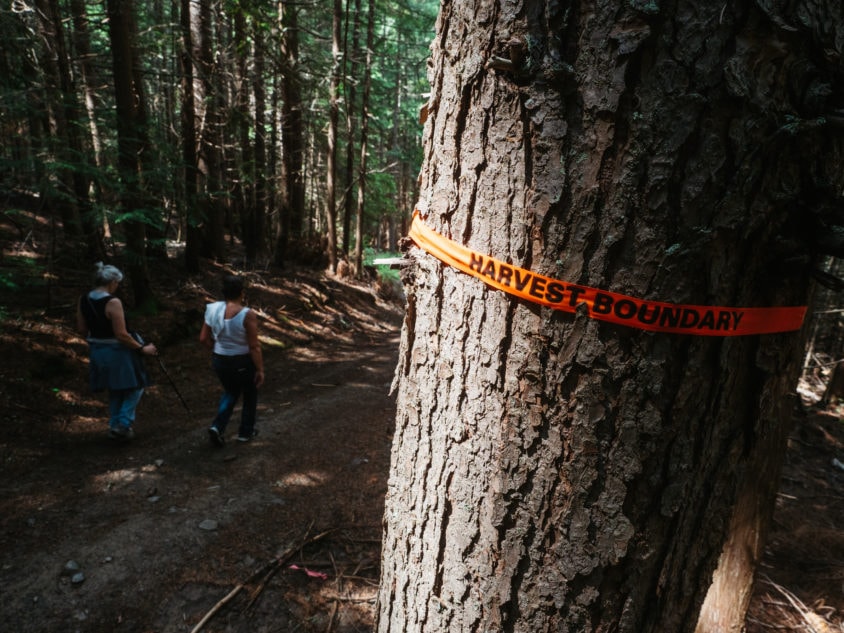
Heather McSwan (left) and Barbarah Nicoll walk down a transmission line service road that leads past several proposed cutblocks in the Glade Watershed. Photo: Louis Bockner / The Narwhal
In 2016, the Glade Watershed Protection Society asked the Interior Health Authority to investigate concerns that logging would affect the quality and reliability of the community’s drinking water — already under a boil water notice because it is a surface water source.
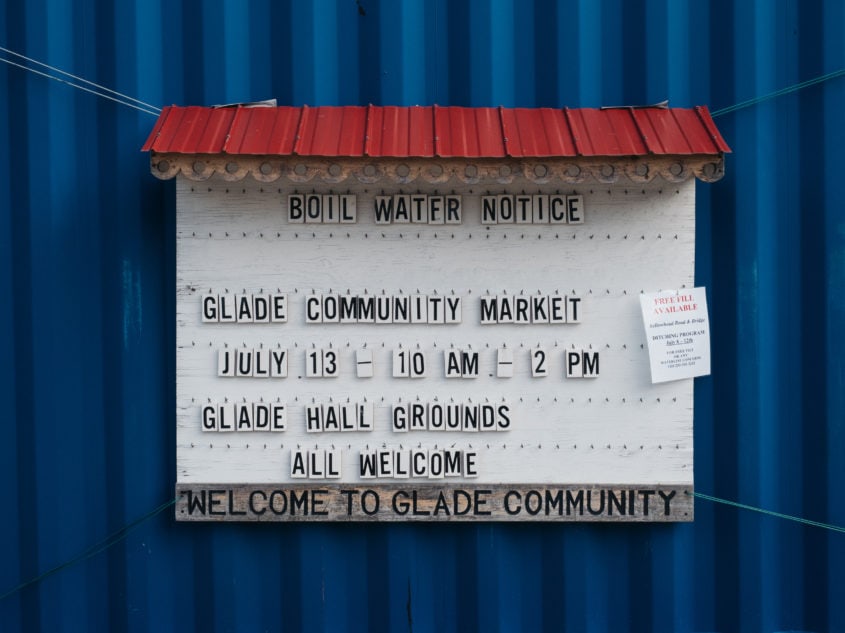
A sign on the Glade side of the Kootenay River welcomes visitors to the community. Photo: Louis Bockner / The Narwhal
A year later, the authority’s environmental health officer informed the society there was not enough evidence to warrant an investigation under section 29 of B.C.’s Drinking Water Protection Act.
“As a matter of jurisdiction, we believe it is not appropriate to apply a Section 29 investigation to the legal framework and approvals processes of forestry activities of MFLNRO [the forests ministry],” said the March 2017 letter from the Interior Health Authority.
The Glade society also filed a complaint with the Forest Practices Board, saying the timber companies’ forest stewardship plans — along with the hydrology report commissioned by the companies in keeping with B.C.’s much-criticized professional reliance model — did not meet government objectives for community watersheds.
In May, the board told the society it is satisfied that the report and stewardship plans meet current government objectives. The society is now waiting for the board’s report to be released.
With limited options left, McSwan and other Glade residents plan to launch a judicial review of the health authority’s decision not to conduct an investigation into drinking water quality.
“We’re saying the whole process was skewed, for a number of reasons,” McSwan explained.
“I still hold out hope. And that’s because I see a lot more people in positions of authority and people with scientific knowledge saying the same thing we are saying: that conventional logging cannot proceed.”
Hammond said the climate emergency provides ample social licence for the government to cancel logging tenures in watersheds and provide a transition period to put control of forests “back in the hands of publicly accountable agencies that place ecosystem services and social well-being ahead of short-term profit taking.”
Watson believes B.C. needs a model where communities become stewards of the forests in their own backyards, so community safety is paramount and forests can be managed for resiliency in the face of climate change.
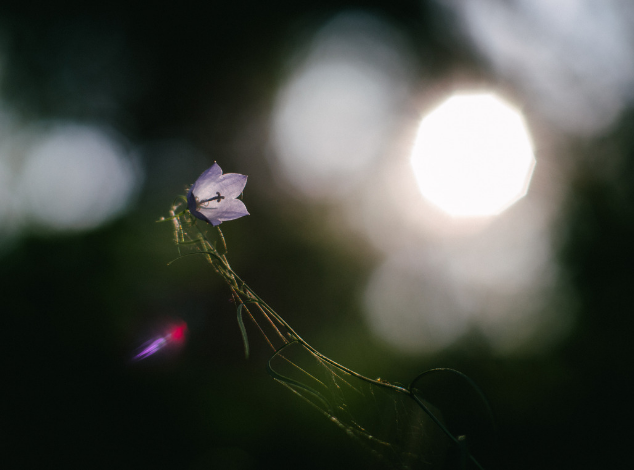
A Campanula rotundifolia, or harebell, blooms in the Glade Watershed. Photo: Louis Bockner / The Narwhal
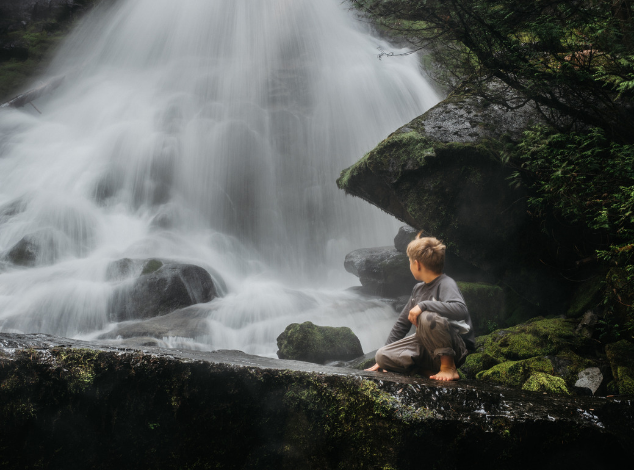
Carmi Restrick sits at the base of the Glade Creek waterfall. His grandmother Heather McIntyre is one of the community members leading the fight against the proposed logging in the watershed. Photo: Louis Bockner / The Narwhal
Both Watson and Davidoff said studies about potential threats to drinking water and community safety need to be carried out by independent scientists, not by scientists hired by logging companies, which often leads to dueling science when communities commission their own reports.
The Kootenays are in a “transition economy,” Watson pointed out.
“There’s no hiding behind ‘let’s keep doing things the old way.’ We’re out of logs. Our forests are burning.”
“I’m not out there saying logging is good or logging is bad. But at the end of the day being safe in your home and having access to clean water is something no-one’s going to debate and I can very much advocate for.”
Instead of becoming a divisive “us and them” issue, Watson says logging in watersheds near communities offers a critical opportunity to discuss things that are not negotiable and an opportunity for B.C. to look at entire landscapes in light of climate change.
“We can’t negotiate the fact that the climate is changing,” she said. “You can’t negotiate the fact that communities are at risk.”
“We need to put all our egos aside and really get down to data and facts, and face the fact that we can do a much better job of what we’re doing. We can either get through this really, really well or we can all go down in flames.”
This article was produced in partnership with the Small Change Fund.
Get the inside scoop on The Narwhal’s environment and climate reporting by signing up for our free newsletter. On a warm September evening nearly 15...
Continue reading
10 billion litres of sewage are dumped into Winnipeg’s lakes and rivers each year. Some...

Court sides with Xatśūll First Nation, temporarily halting Mount Polley mine waste expansion

Break out the champagne: Emma’s storied life and leadership in journalism has earned her the...
